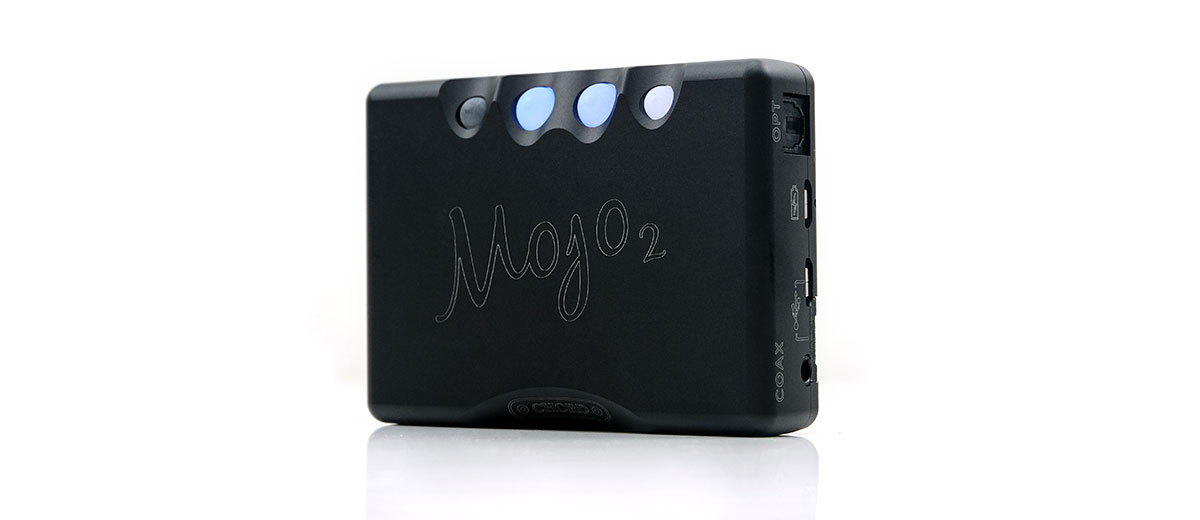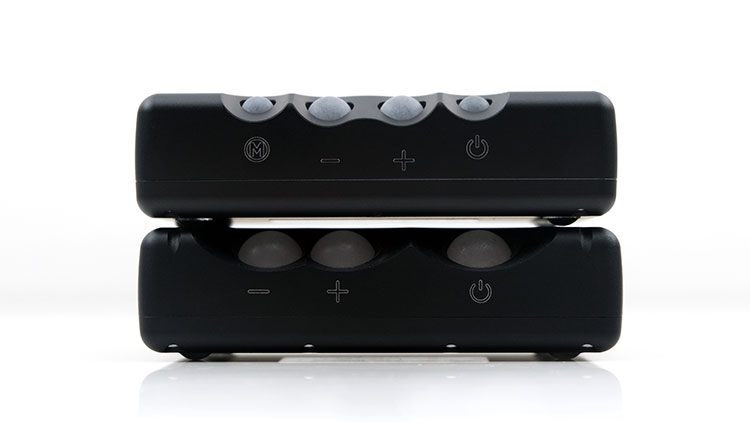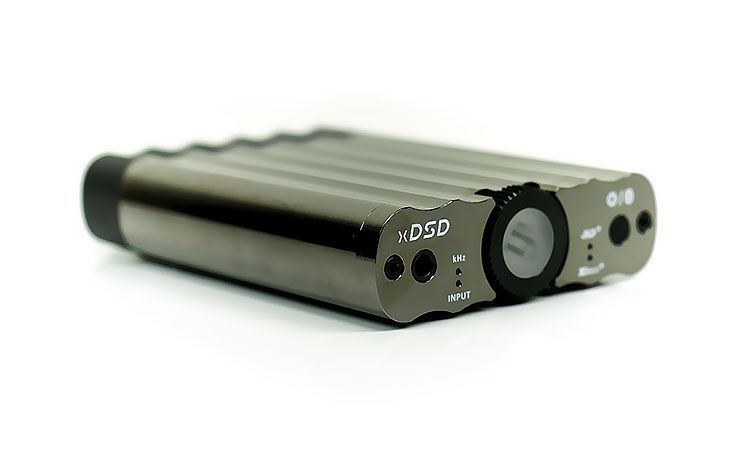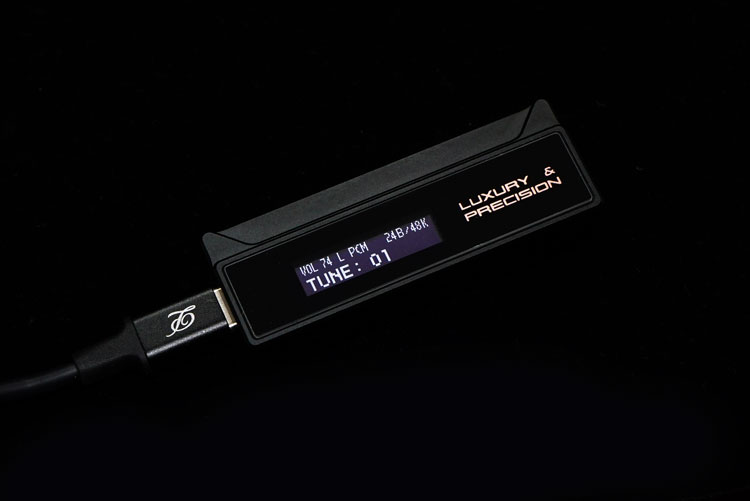Select Comparisons
All comparisons were completed with a Campfire Audio Andromeda 2020, Empire Ears Legend EVO, and a Vision Ears EXT and connected via USB-C to a Samsung Z Flip 3 smartphone.
Chord Electronics Mojo (V1)
£399
The Mojo V1 is perhaps one of the most durable and future-proofed portable audio products to hit the market in the last 5-6 years and is still going strong today.
Technical
As outlined in detail on page one, you are getting a plethora of upgrades here both headline and more subtle. That includes an increase in the FIR tap capability of the in-house DAC from 38,912 to 40,960, the all-new UHD DSP suite, crossfeed filters, and menu system, as well as the addition of a more modern USB-C port for data transfer and OTG.
What has been retained is the micro-USB charging and data ports, primarily for compatibility with the Poly, as well as the coaxial and SPDIF inputs to the rear and the dual SE 3.5mm outputs to the front.
Decoding is unchanged, interestingly enough though the original was incredibly future-proofed, to begin with. Both are capable of up to PCM 32BIT/768kHz and DSD256. M Scaler owners can upsample the Mojo 2 and the original Mojo to 768kHz also.
Output power seems unchanged also at 600mW into 30Ω single-ended down to 90mW into 300Ω, (35mW into 600Ω), with similar dynamic range performances of 125dB each. However, the original’s 3.1v line-level mode has been removed on the Mojo 2.
Battery management has been upgraded on the new Mojo 2 with that FPGA-controlled battery management system. You get a cooler faster charge and slightly improved battery life though both are officially rated at 8 hours each.
Design
Not a huge number of changes physically aside from the new 4 button control system and the additional USB-C port to the rear. Both are robust, compact, and beautifully finished CNC machined aluminum bodies with smooth cornering. They are also both fairly light with only a 5g difference in weight at 180g for the old and 185g for the Mojo 2.
Nuanced changes include the smaller recessed oval shape on the left panel for the Chord branding and the lighter white print for the labeling. The method behind adding the new USB-C is a bit awkward looking on the new Mojo 2 with its plastic insert counting as one of the 4 feet. Never feels quite as balanced design-wise as the original.
The orb control system is more complex on the Mojo 2 with that new menu system but after a few goes, it is not as difficult as I anticipated it to be. You do get a more immersive experience and a lot more options than with the original in terms of built-in sound shaping features.
Performance
The original Mojo is warmer and perhaps less precise, especially in the treble and upper mids percussion. It delivers what I would call an easy-going tuning but with some good bass body so music can often sound weightier and more voluminous on the low-end.
By comparison, the Mojo 2 has a more neutral stock sound quality that delivers a slightly cleaner midrange and treble timbre on our tested Andromeda 2020.
There is also a bit more ‘drive’ on the low-end though not quite the same warmth. Still quite a natural sound for me and not cold at all but rather a more accurate life-like tone. The dynamism from the low-end has also been given a lift. You can sense the Mojo 2 has a better PRaT or an improved sense of timing with increased energy across the range.
The Mojo 1 sounds the more languid of the two in terms of timing with a slightly slower transient response performance from our tested monitors. Vocals are just slightly further forward and more euphonic on the original but not quite as clean and precise.
That feeds into lower pitching instruments that come to the fore with ‘improved ‘character’ as I call it from the Mojo 2. Bass guitar plucks have better definition throughout the note whereas the Mojo 1 sounds a little more one-dimensional in its shaping.
The Mojo 2’s better control and more neutral coloration also improve the staging in terms of imaging accuracy and instrumental separation. You can detect a bit more air and space in the mids and an improved treble presence to go along with it.
iFi Audio xDSD
$399
An amp/DAC from 2018 that is still going strong also in 2022 and though the new Gryphon version has stolen its thunder a bit it does seem iFi Audio is not discontinuing the xDSD for now. Sadly, the Gryphon version is being reviewed by Louis so I am unable to compare the Mojo 2 to it.
Technical
Inside, the xDSD uses a Burr-Brown PCM1793 Multibit hybrid DAC as opposed to the Mojo 2’s in-house developed FPGA-based DAC. The PCM1793 is fairly long in the tooth but has been a staple in iFi Audio products for years. They are still using a Burr-Brown in the recently launched Gryphon version of the xDSD so clearly a love affair for iFi.
In terms of decoding both devices are still quite strong in this department and in fact, the xDSD is higher on paper up to PCM 32BIT/768kHz and DSD512 whereas the Mojo 2 is as good for PCM but stops short at DSD256.
The Mojo 2 does not do MQA either whereas the xDSD is ‘MQA ready’ and can render up to 192kHz. However, if you wish to upsample the Mojo can up to 768kHZ via connecting to the Hugo M Scaler, (if you have one).
The Mojo will give you a stronger output rating from its Class A amp at 600mW into 30Ω whereas the xDSD’s OV4627 ultra-low noise FET input Opamp tops out at 500mW and into a much lower load also at 16Ω. Neither offers a dedicated balanced output but the xDSD does have its dual-mono implementation to allow for its S-Balanced tech (3.5mm 4-pole) to work.
One final bonus on the xDSD is a BT module with aptX decoding capability. You can jump well beyond with WiFi lossless decoding with the Poly connected to the Mojo 2 but it will cost you a lot more.
Design
Both are beautifully designed compact DAC/Amps with the xDSD flashing that ribbed aluminum housing compared to the even more robust and lower-profile black CNC’ed aluminum of the Mojo 2.
The xDSD is a little thinner and wider than the Mojo 2 but that curvy exterior might make it a little harder to velcro strap and stack and its silvery finish can be a bit of a fingerprint magnet also.
In terms of useability, the I/O of the Mojo 2 is much more user-friendly and modern compared to the xDSD. It has a standard USB-C for OTG and data transfer as well as a micro-USB for the same duties and charging.
The xDSD uses an awkward male USB-A port with a rubber cap for OTG and data transfer with a micro-USB for charging alongside a 3.5mm coaxial/TOSLINK combo SPDIF input. I can never really understand that and perhaps iFi felt the same way as the new Gryphon version is all USB-C.
DSP is a very interesting feature here as both devices have it as their centerpiece. I have to say the Mojo 2’s UHD DSP controls are much more in-depth and tweakable compared to the more one-dimensional 3D+ Matrix and XBass+ technology. I mean I enjoy what they do but they have a fixed output whereas the Mojo 2’s DSP can affect vast areas of the FR dB by dB.
Stock Performance
The stock xDSD tuning might sound like the busier of the two portable amps but for me, the Mojo 2 is the cleaner sounding as well as offering the blacker background.
What I mean by busier is actually the more aggressive in terms of upper-mids emphasis and treble presence when pairing the xDSD with the EXT and the EVO.
The Mojo 2 definitely extends deeper, and of the two generates more power and a denser sound. The xDSD is punchy but not as deep, a bit more neutral right at the very low-end, and less distinct in its bass delivery as a result.
Not that the xDSD is clinical in its presentation but rather the treble/upper-mids presence is more in your face whereas the Mojo 2 just takes a back a shade to deliver a more natural smoother tone. Percussion on the xDSD with the EXT is snappy, a bit more contrast tonally, but not quite as smooth or natural-sounding, perhaps a bit drier in its higher-pitching timbre.
DSP Performance
With the 3D+ Matrix and XBass+ turned on the xDSD gets a big lift with a lot more body and amplitude on the low-end and a bit more warmth creeping into the bass to mids timbre as a result. Treble timbre does not change so much for me, still sounding a bit drier or digital sounding.
Yes, the xDSD presets are definitely more bass present than the Mojo 2 but perhaps lacking in refinement as a result. It can overpower and become the centerpiece on some bass-heavy tracks so I would use it with caution despite its very fun-sounding profile.
The UHD DSP on the Mojo 2 can get you more control over how much additional warmth and bass you want also but the unique split shelf on the low-end and that 18dB swing means I can fine-tune it a lot better so it has just as much power but not as boomy as the xDSD XBass.
I can also up the treble presence to balance that out or focus the mids better depending on what IEM I am pairing it with to get the balance just right. A lot more flexibility there and a lot more refined as a result.
Luxury & Precision W2
Audiophile dongles are a fast-growing niche and slowly shrinking the space for budget DAPs and portable amp/DACs to thrive. I consider the W2 and Cayin’s RU6 to be the best of the dongle class portable amp/DACs currently on the market.
$299
Technical
Both devices use FPGA but in the W2 it’s a digital bridge for DSP feeding into a dual CS43198 delta-sigma DAC implementation. The Mojo 2 DAC is FIR filter tap-based with no DAC chip solution, an entirely in-house solution. You get a much lower tap count from delta-sigma DACs in general compared to the Mojo 2’s DAC.
For decoding the W2 is quite competitive with the right app and should have no issues getting around Android limitations in terms of sampling rates. It can decode up to DSD256, the same as the Mojo 2, but stops at 32BIT/384Khz whereas the Mojo 2 is future-proofed right up to 768kHz.
However, for power, the Mojo 2 is well ahead with its built-in Class A amp offering up to 600mW into a 30Ω compared to the weaker 230mW @32Ω from the W2. That is also maximum balanced from the W2, single-ended is 125mW. So yes, the W2 will give you the option of balanced 4.4mm and 3.5mm SE but both are not as powerful as the SE of the Mojo 2.
The W2 is battery-free also which means it draws its power from your smartphone battery and drains it quickly for that matter. The Mojo 2 has its own battery, and can give you just over 8 hours via OTG from a smartphone. Both can hook up as a USB-DAC to a PC or MAC where battery drain is less of an issue.
Both have a focus on DSP with the Mojo 2 offering in-depth UHD DSP controls right across the spectrum to tweak to your heart’s desire. The W2 FPGA DSP engine and digital filters are very good for a dongle, but the DSPs and IEM-specific SDF profiles are preset with no tweaking capability or additional crossfeed filter functionality alongside it.
Design
The biggest asset of the W2 is its size. The Mojo 2 is compact but compared to the diminutive W2 it is huge. That is one of the big reasons why dongles are so popular these days. It is not as robust or as ambitious as the Mojo 2’s design and materials but the W2 aluminum housing and carbon fiber rear panel are still quite nicely crafted.
One area I think the W2 might gain a few more followers on is the LCD screen. It is not huge not everyone will dig the orb color-controlled menu system on the Mojo 2 and sometimes LCD screens with simple controls work better for some, (thinking of those who may be color blind).
The Mojo 2 does have a lot more input options such as coaxial, SPDIF, and USB-C/micro-USB whereas the W2 is more limited with just a USB-C output though it can still adapter its way into a PC, MAC, iPhone, or Android smartphone. The Mojo 2 does make a better choice as a system-focused tool compared to the W2.
One interesting feature is the SPDIF output on the W2 allowing you to bypass the amp and hook up a chain that could include the Mojo 2 itself as your final output. Bear in mind the Mojo 2 has no other outputs than a dual 3.5mm SE on the front panel.
Performance
Testing was done with both the Andromeda 2020 and the VE EXT and between the two the EXT is going to a better pairing with the Mojo 2 compared to the W2.
The W2 is a little more neutral for me and not quite as powerful on the low-end. I also pick up a bit more of a digital overtone from its treble with some of that hitting the upper-mids. Digital claps have plenty of contrast but not quite as much body and textural detail compared to the Mojo 2.
The Mojo 2/EXT combo is really about the additional power on the low-end first and the amount of vocal prominence it can dig out compared to the W2.
This combo sounds a lot weightier and yes, slightly the warmer of the two also. There is more of a liquid natural edge to notes coming from this combination and might I add, all combinations including the Andromeda 2020.
Notes sound bigger, broader, and a little more to the euphonic or natural side whereas the W2 falls back to a more neutral coloration. Not by a huge amount though, I actually think the W2 is fairly well balanced, and like the Mojo 2 noise is not an issue with sensitive IEMs.
However, with more power comes better dynamics from the Mojo 2 with moderately demanding planar headphones such as the Meze Elite offering a lot more punch and scale compared to the W2.
If you are staying within the IEM range the W2 is impressive competitive but if you need additional bass, a slightly smoother denser timbre, and more forward big-sounding vocals the Mojo 2 is more suitable.
Our Verdict
On paper, you might not think the Mojo 2 has enough of an evolution given it’s been almost 6 years since the original first came out. Yup, a USB-C was clearly needed and it has got one now with more complexity in the control system but otherwise, it looks almost the same as before.
However, dig deeper, especially with the new menu system and those UHD DSP controls and you will find a much more mature and customizable Mojo on offer.
Quite apart from a stock sound that feels more accurate and energetic compared to the V1, the Mojo 2’s DSP suite is seamless in terms of having no impact on dynamic range and a lack of volume attenuation. You can hear the changes it makes right away and you tweak it right across the frequency range to suit your tastes.
For those who have the V1, I do encourage you to demo the new Mojo 2 and see just how well the new sound and DSP match your monitors or headphones of choice. For those who do not then it’s a no-brainer, still one of the best sounding portable amp/DACs in this price class in 2022.
Chord Electronics Mojo 2 Specifications
- Dimensions 83 mm x 62 mm x 22.9 mm
- Weight Mojo 2 185 g
- Weight Mojo 2 + Poly 270 g
- Battery life 8 hours (approximately)
- Operating voltage 5 V DC
- Charging current 1.5 A
- Output power @ 1 kHz/300 Ω 90 mW
- Output power @ 1 kHz/30 Ω 600 mW
- Output impedance 0.06 Ω
- Dynamic range 125 dB
- THD @ 2.5 V/300 Ω 0.0003%






